A Review of Femtosecond Laser-Induced Emission Techniques for Combustion and Flow Field Diagnostics
Abstract
:1. Introduction
2. Femtosecond Two-Photon Laser-Induced Fluorescence (fs-TPLIF)
3. Femtosecond Laser-Induced Breakdown Spectroscopy (fs-LIBS)
4. Femtosecond Laser-Induced Filament Emission
4.1. Spectroscopy Techniques Based on Femtosecond Laser-Induced Filament Emission
4.2. Tagging Velocimetry Based on Femtosecond Laser-Induced Emission
5. Femtosecond Lasers Guided High Voltage Electric Discharges
6. Conclusions
Author Contributions
Funding
Conflicts of Interest
References
- Mock, R.; Meixner, H. A miniaturized high-temperature pressure sensor for the combustion chamber of a spark ignition engine. Sens. Actuators A 1990, 25, 103–106. [Google Scholar] [CrossRef]
- Klopfenstein, R., Jr. Air velocity and flow measurement using a Pitot tube. ISA Trans. 1998, 37, 257–263. [Google Scholar] [CrossRef]
- Heitor, M.V.; Moreira, A.L.N. Thermocouples and sample probes for combustion studies. Prog. Energy Combust. Sci. 1993, 19, 259–278. [Google Scholar] [CrossRef]
- Aldén, M.; Bood, J.; Li, Z.; Richter, M. Visualization and understanding of combustion processes using spatially and temporally resolved laser diagnostic techniques. Proc. Combust. Inst. 2011, 33, 69–97. [Google Scholar] [CrossRef]
- Kohse-Höinghaus, K.; Barlow, R.S.; Aldén, M.; Wolfrum, J. Combustion at the focus: Laser diagnostics and control. Proc. Combust. Inst. 2005, 30, 89–123. [Google Scholar] [CrossRef]
- Hanson, R.K.; Seitzman, J.M.; Paul, P.H. Planar laser-fluorescence imaging of combustion gases. Appl. Phys. B 1990, 50, 441–454. [Google Scholar] [CrossRef]
- Crosley, D.R.; Smith, G.P. Laser-induced fluorescence spectroscopy for combustion diagnostics. Opt. Eng. 1983, 22, 545–553. [Google Scholar] [CrossRef]
- Aldén, M.; Omrane, A.; Richter, M.; Särner, G. Thermographic phosphors for thermometry: A survey of combustion applications. Prog. Energy Combust. Sci. 2011, 37, 422–461. [Google Scholar] [CrossRef]
- Chan, V.S.S.; Turner, J.T. Velocity measurement inside a motored internal combustion engine using three-component laser Doppler anemometry. Opt. Laser Technol. 2000, 32, 557–566. [Google Scholar] [CrossRef]
- Shaddix, C.R.; Smyth, K.C. Laser-induced incandescence measurements of soot production in steady and flickering methane, propane, and ethylene diffusion flames. Combust. Flame 1996, 107, 418–452. [Google Scholar] [CrossRef]
- Spence, D.E.; Kean, P.N.; Sibbett, W. 60-fsec pulse generation from a self-mode-locked Ti: Sapphire laser. Opt. Lett. 1991, 16, 42–44. [Google Scholar] [CrossRef] [PubMed]
- Chin, S.L.; Xu, H. Tunnel ionization, population trapping, filamentation and applications. J. Phys. B At. Mol. Opt. Phys. 2016, 49, 222003. [Google Scholar] [CrossRef]
- Chin, S.L. Femtosecond Laser Filamentation; Springer: New York, NY, USA, 2010; Volume 55, p. 137. [Google Scholar]
- Eckbreth, A.C. Recent advances in laser diagnostics for temperature and species concentration in combustion. Symp. Combust. 1981, 18, 1471–1488. [Google Scholar] [CrossRef]
- Hassel, E.P.; Linow, S. Laser diagnostics for studies of turbulent combustion. Meas. Sci. Technol. 2000, 11, R37. [Google Scholar] [CrossRef]
- Hanson, R.K. Combustion diagnostics: Planar imaging techniques. Symp. Combust. 1986, 21, 1677–1691. [Google Scholar] [CrossRef]
- Lucht, R.P.; Salmon, J.T.; King, G.B.; Sweeney, D.W.; Laurendeau, N.M. Two-photon-excited fluorescence measurement of hydrogen atoms in flames. Opt. Lett. 1983, 8, 365–367. [Google Scholar] [CrossRef] [PubMed]
- Gathen, V.S.V.D.; Niemi, K. Absolute atomic oxygen density measurements by two-photon absorption laser-induced fluorescence spectroscopy in an RF-excited atmospheric pressure plasma jet. Plasma Sources Sci. Technol. 2005, 14, 375. [Google Scholar]
- Rosell, J.; Sjöholm, J.; Richter, M.; Aldén, M. Comparison of three schemes of two-photon laser-induced fluorescence for CO detection in flames. Appl. Spectrosc. 2013, 67, 314–320. [Google Scholar] [CrossRef]
- Bokor, J.; Freeman, R.R.; White, J.C.; Storz, R.H. Two-photon excitation of the level in H and D atoms. Phys. Rev. A At. Mol. Opt. Phys. 1981, 24, 612–614. [Google Scholar] [CrossRef]
- Aldén, M.; Edner, H.; Grafström, P.; Svanberg, S. Two-photon excitation of atomic oxygen in a flame. Opt. Commun. 1982, 42, 244–246. [Google Scholar] [CrossRef]
- Bischel, W.K.; Perry, B.E.; Crosley, D.R. Two-photon laser-induced fluorescence in oxygen and nitrogen atoms. Chem. Phys. Lett. 1981, 82, 85–88. [Google Scholar] [CrossRef]
- DiMauro, L.F.; Gottscho, R.A.; Miller, T.A. Two-photon laser-induced fluorescence monitoring of O atoms in a plasma etching environment. J. Appl. Phys. 1984, 56, 2007–2011. [Google Scholar] [CrossRef]
- Kulatilaka, W.D.; Frank, J.H.; Patterson, B.D.; Settersten, T.B. Analysis of 205-nm photolytic production of atomic hydrogen in methane flames. Appl. Phys. B 2009, 97, 227–242. [Google Scholar] [CrossRef]
- Li, B.; Jonsson, M.; Algotsson, M.; Bood, J.; Li, Z.S.; Johansson, O.; Aldén, M.; Tunér, M.; Johansson, B. Quantitative detection of hydrogen peroxide in an HCCI engine using photofragmentation laser-induced fluorescence. Proc. Combust. Inst. 2013, 34, 3573–3581. [Google Scholar] [CrossRef]
- Li, B.; Zhang, D.; Yao, M.; Li, Z. Strategy for single-shot CH3 imaging in premixed methane/air flames using photofragmentation laser-induced fluorescence. Proc. Combust. Inst. 2017, 36, 4487–4495. [Google Scholar] [CrossRef]
- Li, B.; Li, X.; Zhang, D.; Gao, Q.; Yao, M.; Li, Z. Comprehensive CO detection in flames using femtosecond two-photon laser-induced fluorescence. Opt. Express 2017, 25, 25809–25818. [Google Scholar] [CrossRef]
- Settersten, T.B.; Dreizler, A.; Farrow, R.L. Temperature- and species-dependent quenching of CO B probed by two-photon laser-induced fluorescence using a picosecond laser. J. Chem. Phys. 2002, 117, 3173–3179. [Google Scholar] [CrossRef]
- Frank, J.H.; Settersten, T.B. Two-photon LIF imaging of atomic oxygen in flames with picosecond excitation. Proc. Combust. Inst. 2005, 30, 1527–1534. [Google Scholar] [CrossRef]
- Kulatilaka, W.D.; Gord, J.R.; Katta, V.R.; Roy, S. Photolytic-interference-free, femtosecond two-photon fluorescence imaging of atomic hydrogen. Opt. Lett. 2012, 37, 3051–3053. [Google Scholar] [CrossRef]
- Stauffer, H.U.; Kulatilaka, W.D.; Gord, J.R.; Roy, S. Laser-induced fluorescence detection of hydroxyl (OH) radical by femtosecond excitation. Opt. Lett. 2011, 36, 1776–1778. [Google Scholar] [CrossRef]
- Stauffer, H.U.; Gord, J.R.; Roy, S.; Kulatilaka, W.D. Detailed calculation of hydroxyl (OH) radical two-photon absorption via broadband ultrafast excitation. J. Opt. Soc. Am. B Opt. Phys. 2011, 29, 40–52. [Google Scholar] [CrossRef]
- Wang, Y.; Jain, A.; Kulatilaka, W. CO imaging in piloted liquid-spray flames using femtosecond two-photon LIF. Proc. Combust. Inst. 2019, 37, 1305–1312. [Google Scholar] [CrossRef]
- Wang, Y.; Kulatilaka, W.D. Detection of carbon monoxide (CO) in sooting hydrocarbon flames using femtosecond two-photon laser-induced fluorescence (fs-TPLIF). Appl. Phys. B 2018, 124. [Google Scholar] [CrossRef]
- Rahman, K.A.; Patel, K.S.; Slipchenko, M.N.; Meyer, T.R.; Zhang, Z.; Wu, Y.; Gord, J.R.; Roy, S. Femtosecond, two-photon, laser-induced fluorescence (TP-LIF) measurement of CO in high-pressure flames. Appl. Opt. 2018, 57, 5666–5671. [Google Scholar] [CrossRef] [PubMed]
- Wang, Y.; Kulatilak, W.D. Investigation of Femtosecond two-photon LIF of CO at elevated pressures. In Laser Applications to Chemical, Security and Environmental Analysis; Optical Society of America: Orlando, FL, USA, 2018. [Google Scholar]
- Richardson, D.R.; Roy, S.; Gord, J.R. Femtosecond, two-photon, planar laser-induced fluorescence of carbon monoxide in flames. Opt. Lett. 2017, 42, 875–878. [Google Scholar] [CrossRef]
- Richardson, D.R.; Roy, S.; Gord, J.R. Carbon monoxide femtosecond TALIF in turbulent flames. In Proceedings of the AIAA Aerospace Sciences Meeting, Kissimmee, FL, USA, 8–12 January 2018. [Google Scholar]
- Jain, A.; Wang, Y.; Kulatilaka, W.D. Effect of H-atom concentration on soot formation in premixed ethylene/air flames. Proc. Combust. Inst. 2019, 37, 1289–1296. [Google Scholar] [CrossRef]
- Jain, A.; Kulatilaka, W.D. Investigation of multi-photon excitation schemes for detecting atomic hydrogen in flames. In Proceedings of the 2018 Conference on Lasers and Electro-Optics (CLEO), San Jose, CA, USA, 13–18 May 2018; pp. 1–2. [Google Scholar]
- Ding, P.; Ruchkina, M.; Liu, Y.; Alden, M.; Bood, J.; Department, O.P.; Lund, U.; Lunds, U.; Fysiska, I. Femtosecond two-photon-excited backward lasing of atomic hydrogen in a flame. Opt. Lett. 2018, 43, 1183–1186. [Google Scholar] [CrossRef] [Green Version]
- Ding, P.; Ruchkina, M.; Liu, Y.; Ehn, A.; Alden, M.; Bood, J. Picosecond backward-propagating lasing of atomic hydrogen via femtosecond 2-photon-excitation in a flame. In Proceedings of the 2018 Conference on Lasers and Electro-Optics (CLEO), San Jose, CA, USA, 13–18 May 2018; pp. 1–2. [Google Scholar]
- Ruchkina, M.; Ding, P.; Ehn, A.; Alden, M.; Bood, J. Spatially-resolved hydrogen atom detection in flames using backward lasing. In Proceedings of the 2018 Conference on Lasers and Electro-Optics (CLEO), San Jose, CA, USA, 13–18 May 2018; pp. 1–2. [Google Scholar]
- Hall, C.A.; Kulatilaka, W.D.; Gord, J.R.; Pitz, R.W. Quantitative atomic hydrogen measurements in premixed hydrogen tubular flames. Combust. Flame 2014, 161, 2924–2932. [Google Scholar] [CrossRef]
- Kulatilaka, W.D.; Gord, J.R.; Roy, S. Femtosecond two-photon LIF imaging of atomic species using a frequency-quadrupled Ti:sapphire laser. Appl. Phys. B 2014, 116, 7–13. [Google Scholar] [CrossRef]
- Kulatilaka, W.; Roy, S.; Gord, J. Multi-photon fluorescence imaging of flame species using femtosecond excitation. In Proceedings of the Aerodynamic Measurement Technology, Ground Testing, and Flight Testing Conference, New Orleans, LA, USA, 25–28 June 2012. [Google Scholar]
- Jain, A.; Kulatilaka, W.D. Two- and three-photon LIF detection of atomic hydrogen using femtosecond laser Pulses. In Proceedings of the Laser Applications to Chemical, Security and Environmental Analysis, Orlando, FL, USA, 25–28 June 2018. [Google Scholar]
- Jain, A.; Wang, Y.; Kulatilaka, W.D. Spatially resolved atomic hydrogen concentration measurements in sooting hydrocarbon flames using femtosecond two-photon LIF. In Proceedings of the 33rd AIAA Aerodynamic Measurement Technology and Ground Testing Conference, Denver, CO, USA, 5–9 June 2017. [Google Scholar]
- Schmidt, J.B.; Roy, S.; Kulatilaka, W.D.; Shkurenkov, I.; Adamovich, I.V.; Lempert, W.R.; Gord, J.R. Femtosecond, two-photon-absorption, laser-induced-fluorescence (fs-TALIF) imaging of atomic hydrogen and oxygen in non-equilibrium plasmas. J. Phys. D Appl. Phys. 2017, 50, 015204. [Google Scholar] [CrossRef]
- Schmidt, J.B.; Kulatilaka, W.D.; Roy, S.; Frederickson, K.; Lempert, W.R.; Gord, J.R. Femtosecond TALIF imaging of atomic hydrogen in pulsed, non-equilibrium plasmas. In Proceedings of the 52nd Aerospace Sciences Meeting, National Harbor, MD, USA, 13–17 January 2015. [Google Scholar]
- Li, B.; Zhang, D.; Li, X.; Gao, Q.; Yao, M.; Li, Z. Strategy of interference-free atomic hydrogen detection in flames using femtosecond multi-photon laser-induced fluorescence. Int. J. Hydrog. Energy 2017, 42, 3876–3880. [Google Scholar] [CrossRef]
- Kulatilaka, W.D.; Roy, S.; Jiang, N.; Gord, J.R. Photolytic-interference-free, femtosecond, two-photon laser-induced fluorescence imaging of atomic oxygen in flames. Appl. Phys. B 2016, 122. [Google Scholar] [CrossRef]
- Schmidt, J.B.; Sands, B.L.; Kulatilaka, W.D.; Roy, S.; Scofield, J.; Gord, J.R. Femtosecond, two-photon laser-induced-fluorescence imaging of atomic oxygen in an atmospheric-pressure plasma jet. Plasma Sources Sci. Technol. 2015, 24, 032004. [Google Scholar] [CrossRef]
- Wang, Y.; Capps, C.; Kulatilaka, W.D. Mixture fraction imaging using femtosecond TPLIF of Krypton. In Proceedings of the AIAA Aerospace Sciences Meeting, Grapevine, TX, USA, 9–13 January 2017. [Google Scholar]
- Wang, Y.; Kulatilaka, W.D. Two-photon laser induced fluorescence of krypton using femtosecond pulses. In Proceedings of the Conference on Lasers and Electro-Optics (CLEO), San Jose, CA, USA, 14–19 May 2017; pp. 1–2. [Google Scholar]
- Wang, Y.; Capps, C.; Kulatilaka, W.D. Femtosecond two-photon laser-induced fluorescence of krypton for high-speed flow imaging. Opt. Lett. 2017, 42, 711–714. [Google Scholar] [CrossRef] [PubMed]
- Richardson, D.R.; Jiang, N.; Stauffer, H.U.; Kearney, S.P.; Roy, S.; Gord, J.R. Mixture-fraction imaging at 1 kHz using femtosecond laser-induced fluorescence of krypton. Opt. Lett. 2017, 42, 3498–3501. [Google Scholar] [CrossRef] [PubMed]
- Burluka, A. Combustion Physics; Wiley-VCH Verlag GmbH & Co. KGaA: Weinheim, Germany, 2010. [Google Scholar]
- Settersten, T.B.; Dreizler, A.; Patterson, B.D.; Schrader, P.E.; Farrow, R.L. Photolytic interference affecting two-photon laser-induced fluorescence detection of atomic oxygen in hydrocarbon flames. Appl. Phys. B 2003, 76, 479–482. [Google Scholar] [CrossRef]
- Singh, S.; Musculus, M.P.B.; Reitz, R.D. Mixing and flame structures inferred from OH-PLIF for conventional and low-temperature diesel engine combustion. Combust. Flame 2009, 156, 1898–1908. [Google Scholar] [CrossRef]
- Donbar, J.M.; Driscoll, J.F.; Carter, C.D. Reaction zone structure in turbulent nonpremixed jet flames-from CH-OH PLIF images. Combust. Flame 2000, 122, 1–19. [Google Scholar] [CrossRef]
- Li, Z.S.; Li, B.; Sun, Z.W.; Bai, X.S.; Aldén, M. Turbulence and combustion interaction: High resolution local flame front structure visualization using simultaneous single-shot PLIF imaging of CH, OH, and CH2O in a piloted premixed jet flame. Combust. Flame 2010, 157, 1087–1096. [Google Scholar] [CrossRef]
- Duwig, C.; Li, B.; Li, Z.S.; Aldén, M. High resolution imaging of flameless and distributed turbulent combustion. Combust. Flame 2012, 159, 306–316. [Google Scholar] [CrossRef]
- Laurendeau, N.M.; Goldsmith, J.E.M. Comparison of hydroxyl concentration profiles using five laser-induced fluorescence methods in a lean subatmospheric-pressure H2/O2/Ar flame. Combust. Sci. Technol. 1989, 63, 139–152. [Google Scholar] [CrossRef]
- Renfro, M.W.; Guttenfelder, W.A.; King, G.B.; Laurendeau, N.M. Scalar time-series measurements in turbulent CH4/H2/N2 nonpremixed flames: OH. Combust. Flame 2000, 123, 389–401. [Google Scholar] [CrossRef]
- Westblom, U.; Bengtsson, P.E.; Aldén, M. Carbon atom fluorescence and C2 emission detected in fuel-rich flames using a UV laser. Appl. Phys. B 1991, 52, 371–375. [Google Scholar] [CrossRef]
- Das, P.; Ondrey, G.S.; van Veen, N.; Bersohn, R. Two photon laser induced fluorescence of carbon atoms. J. Chem. Phys. 1983, 79, 724–726. [Google Scholar] [CrossRef]
- Zhang, D.Y.; Gao, Q.; Li, B.; Li, Z.S. Ammonia measurements with femtosecond laser-induced plasma spectroscopy. Appl. Opt. B 2019, 58, 1210–1214. [Google Scholar] [CrossRef]
- Bol’Shakov, A.A.; Yoo, J.H.; Liu, C.; Plumer, J.R.; Russo, R.E. Laser-induced breakdown spectroscopy in industrial and security applications. Appl. Opt. 2010, 49, C132–C142. [Google Scholar] [CrossRef]
- Choi, I.; Chan, G.C.Y.; Mao, X.; Perry, D.L.; Russo, R.E. Line selection and parameter optimization for trace analysis of uranium in glass matrices by laser-induced breakdown spectroscopy (LIBS). Appl. Spectrosc. 2013, 67, 1275–1284. [Google Scholar] [CrossRef]
- Bonta, M.; Gonzalez, J.J.; Quarles, C.D., Jr.; Russo, R.E.; Hegedus, B.; Limbeck, A. Elemental mapping of biological samples by the combined use of LIBS and LA-ICP-MS. J. Anal. At. Spectrom. 2016, 1, 252–258. [Google Scholar] [CrossRef]
- Rehse, S.J.; Salimnia, H.; Miziolek, A.W. Laser-induced breakdown spectroscopy (LIBS): An overview of recent progress and future potential for biomedical applications. J. Med. Eng. Technol. 2012, 36, 77–89. [Google Scholar] [CrossRef] [PubMed]
- Singh, M.; Karki, V.; Mishra, R.K.; Kumar, A.; Kaushik, C.P.; Mao, X.; Russo, R.E.; Sarkar, A. Analytical spectral dependent partial least squares regression: A study of nuclear waste glass from thorium based fuel using LIBS. J. Anal. At. Spectrom. 2015, 3, 2507–2515. [Google Scholar] [CrossRef]
- Quarles, C.D.; Gonzalez, J.J.; East, L.J.; Yoo, J.H.; Morey, M.; Russo, R.E. Fluorine analysis using Laser Induced Breakdown Spectroscopy (LIBS). J. Anal. At. Spectrom. 2014, 29, 1238–1242. [Google Scholar] [CrossRef]
- Colao, F.; Fantoni, R.; Lazic, V.; Paolini, A.; Fabbri, F.; Ori, G.G.; Marinangeli, L.; Baliva, A. Investigation of LIBS feasibility for in situ planetary exploration: An analysis on Martian rock analogues. Planet. Space Sci. 2004, 52, 117–123. [Google Scholar] [CrossRef]
- Harmon, R.S.; Remus, J.; McMillan, N.J.; McManus, C.; Collins, L.; Gottfried, L.J.L., Jr.; DeLucia, F.C.; Miziolek, A.W. LIBS analysis of geomaterials: Geochemical fingerprinting for the rapid analysis and discrimination of minerals. Appl. Geochem. 2009, 24, 1125–1141. [Google Scholar] [CrossRef]
- Gaudiuso, R.; Dell’Aglio, M.; De Pascale, O.; Senesi, G.S.; De Giacomo, A. Laser induced breakdown spectroscopy for elemental analysis in environmental, cultural heritage and space applications: A review of methods and results. Sensors 2010, 10, 7434–7468. [Google Scholar] [CrossRef] [PubMed]
- Haddad, J.E.; Canioni, L.; Bousquet, B. Good practices in LIBS analysis: Review and advices. Spectrochim. Acta B 2014, 101, 171–182. [Google Scholar] [CrossRef]
- Michel, A.P.M. Review: Applications of single-shot laser-induced breakdown spectroscopy. Spectrochim. Acta B 2010, 65, 185–191. [Google Scholar] [CrossRef]
- Rhodes, W.T. Laser-induced breakdown spectroscopy. In Springer Series in Optical Sciences; Springer: Berlin, Germany, 2014. [Google Scholar]
- Cremers, D.A.; Multari, R.A.; Knight, A.K. Laser-induced breakdown spectroscopy. In Encyclopedia of Analytical Chemistry; 2016; Available online: https://onlinelibrary.wiley.com/doi/10.1002/9780470027318.a5110t.pub3/figures (accessed on 25 April 2019).
- Tian, Z.; Dong, M.; Li, S.; Lu, J. Spatially resolved laser-induced breakdown spectroscopy in laminar premixed methane-air flames. Spectrochim. Acta B 2017, 136, 8–15. [Google Scholar] [CrossRef]
- Kiefer, J.; Zhou, B.; Li, Z.; Aldén, M. Impact of plasma dynamics on equivalence ratio measurements by laser-induced breakdown spectroscopy. Appl. Opt. 2015, 54, 4221–4226. [Google Scholar] [CrossRef]
- Michalakou, A.; Stavropoulos, P.; Couris, S. Laser-induced breakdown spectroscopy in reactive flows of hydrocarbon-air mixtures. Appl. Phys. Lett. 2008, 92, 081501. [Google Scholar] [CrossRef]
- Do, H.; Carter, C.D.; Liu, Q.; Ombrello, T.M.; Hammack, S.; Lee, T.; Hsu, K.Y. Simultaneous gas density and fuel concentration measurements in a supersonic combustor using laser induced breakdown. Proc. Combust. Inst. 2015, 35, 2155–2162. [Google Scholar] [CrossRef] [Green Version]
- Zimmer, L.; Yoshida, S. Feasibility of laser-induced plasma spectroscopy for measurements of equivalence ratio in high-pressure conditions. Exp. Fluids 2012, 52, 891–904. [Google Scholar] [CrossRef]
- Ferioli, F.; Buckley, S.G. Measurements of hydrocarbons using laser-induced breakdown spectroscopy. Combust. Flame 2006, 144, 435–447. [Google Scholar] [CrossRef]
- Kotzagianni, M.; Yuan, R.; Mastorakos, E.; Couris, S. Laser-induced breakdown spectroscopy measurements of mean mixture fraction in turbulent methane flames with a novel calibration scheme. Combust. Flame 2016, 167, 72–85. [Google Scholar] [CrossRef] [Green Version]
- Labutin, T.A.; Lednev, V.N.; Ilyincd, A.A.; Popov, A.M. Femtosecond laser-induced breakdown spectroscopy. J. Anal. At. Spectrom. 2016, 31, 90–118. [Google Scholar] [CrossRef]
- Kotzagianni, M.; Couris, S. Femtosecond laser induced breakdown spectroscopy of air-methane mixtures. Chem. Phys. Lett. 2013, 561–562, 36–41. [Google Scholar] [CrossRef]
- Patnaik, A.K.; Wu, Y.; Hsu, P.S.; Gragston, M.; Zhang, Z.; Gord, J.R.; Roy, S. Simultaneous LIBS signal and plasma density measurement for quantitative insight into signal instability at elevated pressure. Opt. Express 2018, 26, 25750. [Google Scholar] [CrossRef] [PubMed]
- Patnaik, A.K.; Hsu, P.S.; Stolt, A.J.; Estevadeordal, J.; Gord, J.R.; Roy, S. Advantages of ultrafast LIBS for high-pressure diagnostics. Imaging Appl. Opt. 2018. [Google Scholar] [CrossRef]
- Kotzagianni, M.; Couris, S. Femtosecond laser induced breakdown for combustion diagnostics. Appl. Phys. Lett. 2012, 100, 264104. [Google Scholar] [CrossRef]
- Couris, S.; Kotzagianni, M.; Baskevicius, A.; Bartulevicius, T.; Sirutkaitis, V. Combustion diagnostics with femtosecond laser radiation. J. Phys. 2014, 548, 12056. [Google Scholar] [CrossRef]
- Patnaik, A.K.; Hsu, P.S.; Roy, S.; Wu, Y.; Gragston, M.; Zhang, Z.; Gord, J.R. Ultrafast laser-induced-breakdown spectroscopy (LIBS) for F/A-ratio measurement of hydrocarbon flames. In Proceedings of the AIAA Aerospace Sciences Meeting, Kissimmee, FL, USA, 8–12 January 2018. [Google Scholar]
- Braun, A.; Korn, G.; Liu, X.; Du, D.; Squier, J.; Mourou, G. Self-channeling of high-peak-power femtosecond laser pulses in air. Opt. Lett. 1995, 20, 73–75. [Google Scholar] [CrossRef]
- Kasparian, J.; Wolf, J.P. Physics and applications of atmospheric nonlinear optics and filamentation. Opt. Express 2008, 16, 466–493. [Google Scholar] [CrossRef]
- Couairon, A.; Mysyrowicz, A. Femtosecond filamentation in transparent media. Phys. Rep. 2007, 441, 47–189. [Google Scholar] [CrossRef]
- Xu, H.L.; Daigle, J.F.; Luo, Q.; Chin, S.L. Femtosecond laser-induced nonlinear spectroscopy for remote sensing of methane. Appl. Phys. B 2006, 82, 655–658. [Google Scholar] [CrossRef]
- Xu, H.; Cheng, Y.; Chin, S.; Sun, H. Femtosecond laser ionization and fragmentation of molecules for environmental sensing. Laser Photonics Rev. 2015, 9, 275–293. [Google Scholar] [CrossRef]
- Li, H.; Jiang, Y.; Li, S.; Chen, A.; Li, S.; Jin, M. Research on the fluorescence emission from water vapor induced by femtosecond filamentation in air. Chem. Phys. Lett. 2016, 662, 188–191. [Google Scholar] [CrossRef]
- Li, H.; Zang, H.; Xu, H.; Sun, H.; Baltuška, A.; Polynkin, P. Robust Remote sensing of trace-level heavy-metal contaminants in water using laser filaments. Glob. Chall. 2018, 3, 1800070. [Google Scholar] [CrossRef]
- Li, H.L.; Xu, H.L.; Yang, B.S.; Chen, Q.D.; Zhang, T.; Sun, H.B. Sensing combustion intermediates by femtosecond filament excitation. Opt. Lett. 2013, 38, 1250–1252. [Google Scholar] [CrossRef] [PubMed]
- Li, H.; Wei, X.; Xu, H.; Chin, S.; Yamanouchi, K.; Sun, H. Femtosecond laser filamentation for sensing combustion intermediates: A comparative study. Sens. Actuators B Chem. 2014, 203, 887–890. [Google Scholar] [CrossRef]
- Li, H.; Chu, W.; Xu, H.; Cheng, Y.; Chin, S.; Yamanouchi, K.; Sun, H. Simultaneous identification of multi-combustion-intermediates of alkanol-air flames by femtosecond filament excitation for combustion sensing. Sci. Rep. 2016, 6, 27340. [Google Scholar] [CrossRef] [Green Version]
- Li, S.; Li, Y.; Shi, Z.; Sui, L.; Li, H.; Li, Q.; Chen, A.; Jiang, Y.; Jin, M. Fluorescence emission induced by the femtosecond filament transmitting through the butane/air flame. Spectrochim. Acta A 2018, 189, 32–36. [Google Scholar] [CrossRef] [PubMed]
- Li, H.; Chu, W.; Zang, H.; Xu, H.; Cheng, Y.; Chin, S.L. Critical power and clamping intensity inside a filament in a flame. Opt. Express 2016, 24, 3424. [Google Scholar] [CrossRef] [PubMed]
- Chu, W.; Li, H.; Ni, J.; Zeng, B.; Yao, J.; Zhang, H.; Li, G.; Jing, C.; Xie, H.; Xu, H.; et al. Lasing action induced by femtosecond laser filamentation in ethanol flame for combustion diagnosis. Appl. Phys. Lett. 2014, 104, 91106. [Google Scholar] [CrossRef]
- Zang, H.; Li, H.; Su, Y.; Fu, Y.; Hou, M.; Baltuška, A.; Yamanouchi, K.; Xu, H. Third-harmonic generation and scattering in combustion flames using a femtosecond laser filament. Opt. Lett. 2018, 43, 615–618. [Google Scholar] [CrossRef] [PubMed]
- Hartung, G.; Hult, J.; Kaminski, C.F. A flat flame burner for the calibration of laser thermometry techniques. Meas. Sci. Technol. 2006, 17, 2485–2493. [Google Scholar] [CrossRef] [Green Version]
- Liu, X.; Lu, X.; Liu, X.; Xi, T.; Liu, F.; Ma, J.; Zhang, J. Tightly focused femtosecond laser pulse in air: From filamentation to breakdown. Opt. Express 2010, 18, 26007–26017. [Google Scholar] [CrossRef] [PubMed]
- Hsu, P.S.; Patnaik, A.K.; Stolt, A.J.; Estevadeordal, J.; Roy, S.; Gord, J.R. Femtosecond-laser-induced plasma spectroscopy for high-pressure gas sensing: Enhanced stability of spectroscopic signal. Appl. Phys. Lett. 2018, 113, 214103. [Google Scholar] [CrossRef]
- Zhang, D.; Gao, Q.; Li, B.; Zhu, Z.; Li, Z. Instantaneous one-dimensional equivalence ratio measurements in methane/air mixtures using femtosecond laser-induced plasma spectroscopy. Opt. Express 2019, 27, 2159–2169. [Google Scholar] [CrossRef] [PubMed]
- Bruun, H.H. Hot-wire anemometry: Principles and Signal Analysis. Meas. Sci. Technol. 1996, 7. [Google Scholar] [CrossRef]
- Westerweel, J.; Elsinga, G.E.; Adrian, R.J. Particle image velocimetry for complex and turbulent flows. Annu. Rev. Fluid Mech. 2013, 45, 409–436. [Google Scholar] [CrossRef]
- Wereley, S.T.; Meinhart, C.D. Recent advances in micro-particle image velocimetry. Annu. Rev. Fluid Mech. 2010, 42, 557–576. [Google Scholar] [CrossRef]
- Tropea, C. Laser Doppler anemometry: Recent developments and future challenges. Meas. Sci. Technol 1995, 6, 605–619. [Google Scholar] [CrossRef]
- Chen, F.; Li, H.; Hu, H. Molecular tagging techniques and their applications to the study of complex thermal flow phenomenal, 211. Acta. Mech. Sin. 2015, 31, 425–445. [Google Scholar] [CrossRef]
- Lempert, W.R.; Jiang, N.; Sethuram, S.; Mo, S. Molecular tagging velocimetry measurements in supersonic microjets. AIAA J. 2015, 40, 1065–1070. [Google Scholar] [CrossRef]
- Mittal, M.; Sadr, R.; Schock, H.J.; Fedewa, A.; Naqwi, A. In-cylinder engine flow measurement using stereoscopic molecular tagging velocimetry (SMTV). Exp. Fluids 2009, 46, 277–284. [Google Scholar] [CrossRef]
- Krüger, S.; Grünefeld, G. Stereoscopic flow-tagging velocimetry. Appl. Phys. B 1999, 69, 509–512. [Google Scholar] [CrossRef]
- Pan, F.; Sanchez-Gonzalez, R.; McIlvoy, M.H.; Bowersox, R.D.; North, S.W. Simultaneous three-dimensional velocimetry and thermometry in gaseous flows using the stereoscopic vibrationally excited nitric oxide monitoring technique. Opt. Lett. 2016, 41, 1376–1379. [Google Scholar] [CrossRef] [PubMed]
- Sanchez-Gonzalez, R.; Bowersox, R.D.; North, S.W. Simultaneous velocity and temperature measurements in gaseous flowfields using the vibrationally excited nitric oxide monitoring technique: A comprehensive study. Appl. Opt. 2012, 51, 1216–1228. [Google Scholar] [CrossRef]
- Rubinsztein-Dunlop, H.; Littleton, B.; Barker, P.; Ljungberg, P.; Malmsten, Y. Ionic strontium fluorescence as a method for flow tagging velocimetry. Exp. Fluids 2001, 30, 36–42. [Google Scholar] [CrossRef]
- Barker, P.; Thomas, A.; Rubinsztein-Dunlop, H.; Ljungberg, P. Velocity measurements by flow tagging employing laser enhanced ionisation and laser induced fluorescence. Spectrochim. Acta B 1995, 50, 1301–1310. [Google Scholar] [CrossRef]
- Miles, R.B.; Grinstead, J.; Kohl, R.H.; Diskin, G. The RELIEF flow tagging technique and its application in engine testing facilities and for helium-air mixing studies. Meas. Sci. Technol. 2000, 11, 1272–1281. [Google Scholar] [CrossRef]
- Miles, R.; Cohen, C.; Connors, J.; Howard, P.; Huang, S. Velocity measurements by vibrational tagging and fluorescent probing of oxygen. Opt. Lett. 1987, 11, 861–863. [Google Scholar] [CrossRef]
- Dam, N.; Kleindouwel, R.J.; Sijtsema, N.M.; Meulen, J.J. Nitric oxide flow tagging in unseeded air. Opt. Lett. 2001, 26, 36–38. [Google Scholar] [CrossRef] [PubMed]
- Pitz, R.W.; Ribarov, L.A.; Wehrmeyer, J.A.; Batliwala, F.; Debarber, P.A. Ozone tagging velocimetry using narrowband excimer lasers. AIAA J. 1999, 37, 708–714. [Google Scholar]
- Pitz, R.W.; Brown, T.M.; Nandula, S.P.; Skaggs, P.A.; Debarber, P.A.; Brown, M.S.; Segall, J. Unseeded velocity measurement by ozone tagging velocimetry. Opt. Lett. 1996, 21, 755–757. [Google Scholar] [CrossRef] [PubMed]
- Lahr, M.D.; Pitz, R.W.; Douglas, Z.W.; Carter, C.D. Hydroxyl-tagging-velocimetry measurements of a supersonic flow over a cavity. J. Propuls. Power 2010, 26, 790–797. [Google Scholar] [CrossRef]
- Ribarov, L.A.; Wehrmeyer, J.A.; Pitz, R.W.; Yetter, R.A. Hydroxyl tagging velocimetry (HTV) in experimental air flows. Appl. Phys. B 2002, 74, 175–183. [Google Scholar] [CrossRef]
- Boedeker, L.R. Velocity measurement by H2O photolysis and laser-induced fluorescence of OH. Opt. Lett. 1989, 14, 473–475. [Google Scholar] [CrossRef] [PubMed]
- Michael, J.B.; Edwards, M.R.; Dogariu, A.; Miles, R.B. Femtosecond laser electronic excitation tagging for quantitative velocity imaging in air. Appl. Opt. 2011, 26, 5158–5162. [Google Scholar] [CrossRef]
- Jiang, N.; Halls, B.R.; Stauffer, H.U.; Danehy, P.M.; Gord, J.R.; Roy, S. Selective two-photon absorptive resonance femtosecond-laser electronic-excitation tagging velocimetry. Opt. Lett. 2016, 41, 2225–2228. [Google Scholar] [CrossRef]
- Reese, D.; Danehy, P. Application of STARFLEET velocimetry in the NASA langley 0.3-meter transonic cryogenic tunnel. In Proceedings of the Aerodynamic Measurement Technology and Ground Testing Conference, Atlanta, GA, USA, 25–29 June 2018. [Google Scholar]
- Jiang, N.; Halls, B.R.; Stauffer, H.U.; Danehy, P.M.; Gord, J.R.; Roy, S. Selective two-photon absorptive resonance femtosecond-laser electronic-excitation tagging (STARFLEET) velocimetry in flow and combustion diagnostics. In Proceedings of the 32nd AIAA Aerodynamic Measurement Technology and Ground Testing Conference, Washington, DC, USA, 13–17 June 2016. [Google Scholar]
- Jiang, N.; Stauffer, H.U.; Roy, S.; Danehy, P.M.; Halls, B.R.; Gord, J.R. Nitrogen molecular-tagging velocimetry techniques using ultrashort-pulse lasers. In Proceedings of the Laser Applications to Chemical, Security and Environmental Analysis, Heidelberg, Germany, 25–28 July 2016. [Google Scholar]
- Zhang, Y.; Miles, R.B. Femtosecond laser tagging for velocimetry in argon and nitrogen gas mixtures. Opt. Lett. 2018, 43, 551–554. [Google Scholar] [CrossRef]
- Pouya, S.; Van Rhijn, A.; Dantus, M.; Koochesfahani, M. Multi-photon molecular tagging velocimetry with femtosecond excitation (FemtoMTV). Exp. Fluids 2014, 55, 1791. [Google Scholar] [CrossRef]
- Miles, R.B.; Edwards, M.R.; Michael, J.B.; Calvert, N.D.; Dogariu, A. Femtosecond laser electronic excitation tagging (FLEET) for imaging flow structure in unseeded hot or cold air or nitrogen. In Proceedings of the 51st AIAA Aerospace Sciences Meeting including the New Horizons Forum and Aerospace Exposition, Grapevine, TX, USA, 7–10 January 2013. [Google Scholar]
- Burns, R.A.; Danehy, P.M. FLEET velocimetry measurements on a transonic airfoil. In Proceedings of the 55th AIAA Aerospace Sciences Meeting, Grapevine, TX, USA, 9–13 January 2017. [Google Scholar]
- Burns, R.A.; Danehy, P.M.; Halls, B.R.; Jiang, N. Femtosecond laser electronic excitation tagging velocimetry in a transonic, cryogenic wind tunnel. AIAA J. 2016, 55, 680–685. [Google Scholar] [CrossRef]
- Burns, R.; Danehy, P.M.; Jones, S.B.; Halls, B.R.; Jiang, N. Application of FLEET velocimetry in the NASA langley 0.3-meter transonic cryogenic tunnel. In Proceedings of the 31st AIAA Aerodynamic Measurement Technology and Ground Testing Conference, Dallas, TX, USA, 22–26 June 2015. [Google Scholar]
- Dogariu, L.; Dogariu, A.; Smith, M.S.; Marineau, E.C.; Miles, R.B. Hypersonic flow velocity measurements using FLEET. In Proceedings of the 2018 Conference on Lasers and Electro-Optics (CLEO), San Jose, CA, USA, 13–18 May 2018. [Google Scholar]
- Dogariu, L.E.; Dogariu, A.; Miles, R.B.; Smith, M.S.; Marineau, E.C. Non-intrusive hypersonic freestream and turbulent boundary-layer velocity measurements in AEDC tunnel 9 using FLEET. In Proceedings of the AIAA Aerospace Sciences Meeting, Kissimmee, FL, USA, 8–12 January 2018. [Google Scholar]
- Zhang, Y.; Miles, R.B. Shear layer measurements along curved surfaces using the FLEET method. In Proceedings of the AIAA Aerospace Sciences Meeting, Kissimmee, FL, USA, 8–12 January 2018. [Google Scholar]
- Deluca, N.J.; Miles, R.B.; Jiang, N.; Kulatilaka, W.D.; Patnaik, A.K.; Gord, J.R. FLEET velocimetry for combustion and flow diagnostics. Appl. Opt. 2017, 56, 8632–8638. [Google Scholar] [CrossRef]
- Hsu, P.S.; Jiang, N.; Danehy, P.M.; Gord, J.R.; Roy, S. Fiber-coupled ultrashort-pulse-laser-based electronic-excitation tagging velocimetry. Appl. Opt. 2018, 57, 560–566. [Google Scholar] [CrossRef]
- Edwards, M.R.; Dogariu, A.; Miles, R.B. Simultaneous temperature and velocity measurements in air with femtosecond laser tagging. AIAA J. 2015, 53, 2280–2288. [Google Scholar] [CrossRef]
- Edwards, M.R.; Limbach, C.; Miles, R.B.; Tropina, A. Limitations on high-spatial resolution measurements of turbulence using femtosecond laser tagging. In Proceedings of the 53rd AIAA Aerospace Sciences Meeting, Kissimmee, FL, USA, 5–9 January 2015. [Google Scholar]
- Burns, R.A.; Peters, C.J.; Danehy, P.M. Unseeded velocimetry in nitrogen for high-pressure, cryogenic wind tunnels: Part I. Femtosecond-laser tagging. Meas. Sci. Technol. 2018, 29, 115302. [Google Scholar] [CrossRef]
- Zhang, Y.; Shneider, M.N.; Miles, R.B. Femtosecond laser excitation in argon-nitrogen mixtures. AIAA J. 2018, 56, 1060–1071. [Google Scholar] [CrossRef]
- Zhang, Y.; Shneider, M.N.; Miles, R.B. Characterization of intermediate reactions following femtosecond laser excitation in argon-nitrogen mixtures. In Proceedings of the 55th AIAA Aerospace Sciences Meeting, Grapevine, TX, USA, 9–13 January 2017. [Google Scholar]
- Zhang, Y.; Calvert, N.; Shneider, M.N.; Miles, R.B. Enhancement of FLEET in argon gas mixtures. In Proceedings of the 32nd AIAA Aerodynamic Measurement Technology and Ground Testing Conference, Washington, DC, USA, 13–17 June 2016. [Google Scholar]
- Halls, B.R.; Jiang, N.; Gord, J.R.; Danehy, P.M.; Roy, S. Mixture-fraction measurements with femtosecond-laser electronic-excitation tagging. Appl. Opt. 2017, 56, E94–E98. [Google Scholar] [CrossRef] [PubMed]
- Edwards, M.; Dogariu, A.; Miles, R. Simultaneous temperature and velocity measurement in unseeded air flows with FLEET. In Proceedings of the 51st AIAA Aerospace Sciences Meeting including the New Horizons Forum and Aerospace Exposition, Grapevine, TX, USA, 7–10 January 2013. [Google Scholar]
- Zhang, Y.; Miles, R.B.; Danehy, P.M. Femtosecond laser tagging in 1,1,1,2-Tetrafluoroethane with trace quantities of air. In Proceedings of the AIAA Aerospace Sciences Meeting, Kissimmee, FL, USA, 8–12 January 2018. [Google Scholar]
- Calvert, N.; Zhang, Y.; Miles, R.B. Characterizing FLEET for aerodynamic measurements in various gas mixtures and non-air environments. In Proceedings of the 32nd AIAA Aerodynamic Measurement Technology and Ground Testing Conference, Washington, DC, USA, 13–17 June 2016. [Google Scholar]
- Zhang, D.; Li, B.; Gao, Q.; Li, Z. Applicability of femtosecond laser electronic excitation tagging in combustion flow field velocity measurements. Appl. Spectrosc. 2018, 72, 1807–1813. [Google Scholar] [CrossRef]
- Calvert, N.; Dogariu, A.; Miles, R.B. FLEET boundary layer velocity profile measurements. In Proceedings of the 44th AIAA Plasmadynamics and Lasers Conference, San Diego, CA, USA, 24–27 June 2013. [Google Scholar]
- Zhang, Y.; Calvert, N.; Dogariu, A.; Miles, R.B. Towards shear flow measurements using FLEET. In Proceedings of the 54th AIAA Aerospace Sciences Meeting, San Diego, CA, USA, 4–8 January 2016. [Google Scholar]
- Calvert, N.D.; Dogariu, A.; Miles, R.B. 2-D velocity and vorticity measurements with FLEET. In Proceedings of the 30th AIAA Aerodynamic Measurement Technology and Ground Testing Conference, Atlanta, GA, USA, 16–20 June 2014. [Google Scholar]
- Burns, R.A.; Peters, C.J.; Danehy, P.M. Multiparameter flowfield measurements in high-pressure, cryogenic environments using femtosecond lasers. In Proceedings of the 32nd AIAA Aerodynamic Measurement Technology and Ground Testing Conference, Washington, DC, USA, 13–17 June 2016. [Google Scholar]
- Danehy, P.M.; Bathel, B.F.; Calvert, N.D.; Dogariu, A.; Miles, R.B. Three component velocity and acceleration measurement using FLEET. In Proceedings of the 30th AIAA Aerodynamic Measurement Technology and Ground Testing Conference, Atlanta, GA, USA, 16–20 June 2014. [Google Scholar]
- Li, B.; Zhang, D.; Li, X.; Gao, Q.; Zhu, Z.; Li, Z. Femtosecond laser-induced cyano chemiluminescence in methane-seeded nitrogen gas flows for near-wall velocimetry. J. Phys. D Appl. Phys. 2018, 51, 295102. [Google Scholar] [CrossRef] [Green Version]
- Li, X.; Shi, C.; Xu, Y.; Zhang, X.; Wang, K.; Zhu, A. Pulsed streamer discharge plasma over Ni/HZSM-5 catalysts for methane conversion to aromatics at atmospheric pressure. Plasma Process. Polym. 2007, 4, 15–18. [Google Scholar] [CrossRef]
- Naseh, M.V.; Khodadadi, A.A.; Mortazavi, Y.; Pourfayaz, F.; Alizadeh, O.; Maghrebi, M. Fast and clean functionalization of carbon nanotubes by dielectric barrier discharge plasma in air compared to acid treatment. Carbon 2010, 48, 1369–1379. [Google Scholar] [CrossRef]
- Mandolfino, C.; Lertora, E.; Gambaro, C. Influence of cold plasma treatment parameters on the mechanical properties of polyamide homogeneous bonded joints. Surf. Coat. Technol. 2017, 313, 222–229. [Google Scholar] [CrossRef]
- Machala, Z.; Janda, M.; Hensel, K.; Jedlovský, I.; Leštinská, L.; Foltin, V.; Martišovitš, V.; Morvová, M. Emission spectroscopy of atmospheric pressure plasmas for bio-medical and environmental applications. J. Mol. Spectrosc. 2007, 243, 194–201. [Google Scholar] [CrossRef]
- Wang, T.; Wei, Y.; Liu, Y.; Chen, N.; Liu, Y.; Ju, J.; Sun, H.; Wang, C.; Lu, H.; Liu, J.; et al. Direct observation of laser guided corona discharges. Sci. Rep. 2016, 5, 18681. [Google Scholar] [CrossRef]
- Roth, G.J.; Gundersen, M.A. Laser-induced fluorescence images of NO distribution after needle pulsed negative corona discharge. IEEE Trans. Plasma Sci. 2002, 27, 28–29. [Google Scholar] [CrossRef]
- Ballal, D.R.; Lefebvre, A.H. The influence of spark discharge characteristics on minimum ignition energy in flowing gases. Combust. Flame 1975, 24, 99–108. [Google Scholar] [CrossRef]
- Horvatic, V.; Michels, A.; Ahlmann, N.; Jestel, G.; Veza, D.; Vadla, C.; Franzke, J. Time- and spatially resolved emission spectroscopy of the dielectric barrier discharge for soft ionization sustained by a quasi-sinusoidal high voltage. Anal. Bioanal. Chem. 2015, 407, 6689–6696. [Google Scholar] [CrossRef]
- Ambrico, P.F.; Ambrico, M.; Šimek, M.; Colaianni, A.; Dilecce, G.; De Benedictis, S. Laser triggered single streamer in a pin-to-pin coplanar dielectric barrier discharge. Appl. Phys. Lett. 2009, 94, 231501. [Google Scholar] [CrossRef]
- Zhu, J.; Gao, J.; Li, Z.; Ehn, A.; Aldén, A.; Larsson, A.; Kusano, Y. Sustained diffusive alternating current gliding arc discharge in atmospheric pressure air. Appl. Phys. Lett. 2014, 105, 234102. [Google Scholar] [CrossRef] [Green Version]
- Woodworth, J.R.; Frost, C.A.; Green, T.A. UV laser triggering of high-voltage gas switches. J. Appl. Phys. 1982, 53, 4734–4739. [Google Scholar] [CrossRef]
- Zhang, C.; Shao, T.; Yan, P.; Zhou, Y. Nanosecond-pulse gliding discharges between point-to-point electrodes in open air. Plasma Sources Sci. Technol. 2014, 23, 35004. [Google Scholar] [CrossRef]
- Schimmel, G.; Produit, T.; Mongin, D.; Kasparian, J.; Wolf, J. Free space laser telecommunication through fog. Optica 2018, 5, 1338. [Google Scholar] [CrossRef]
- Théberge, F.; Liu, W.; Simard, P.T.; Becker, A.; Chin, S.L. Plasma density inside a femtosecond laser filament in air: Strong dependence on external focusing. Phys. Rev. E 2006, 74, 36406. [Google Scholar] [CrossRef]
- Lechien, K.R.; Savage, M.E.; Anaya, V.; Bliss, D.E.; Clark, W.T.; Corley, J.P.; Feltz, G.; Garrity, J.E.; Guthrie, D.W.; Hodge, K.C. Development of a 5.4 MV laser triggered gas switch for multimodule, multimegampere pulsed power drivers. Rev. Mod. Phys. 2008, 11, 060402. [Google Scholar] [CrossRef]
- Arantchouk, L.; Houard, A.; Brelet, Y.; Carbonnel, J.; Larour, J.; André, Y.B.; Mysyrowicz, A. A simple high-voltage high current spark gap with subnanosecond jitter triggered by femtosecond laser filamentation. Appl. Phys. Lett. 2013, 102, 163502. [Google Scholar] [CrossRef] [Green Version]
- Luther, B.M.; Furfaro, L.; Klix, A.; Rocca, J.J. Femtosecond laser triggering of a sub-100 picosecond jitter high-voltage spark gap. Appl. Phys. Lett. 2001, 79, 3248–3250. [Google Scholar] [CrossRef] [Green Version]
- Arantchouk, L.; Point, G.; Brelet, Y.; Larour, J.; Carbonnel, J.; André, Y.B.; Mysyrowicz, A.; Houard, A. Compact 180-kV Marx generator triggered in atmospheric air by femtosecond laser filaments. Appl. Phys. Lett. 2014, 104, 103506. [Google Scholar] [CrossRef] [Green Version]
- Point, G.; Arantchouk, L.; Thouin, E.; Carbonnel, J.; Mysyrowicz, A.; Houard, A. Long-lived laser-induced arc discharges for energy channeling applications. Sci. Rep. 2017, 7, 13801. [Google Scholar] [CrossRef] [PubMed] [Green Version]
- Clerici, M.; Hu, Y.; Lassonde, P.; Milián, C.; Couairon, A.; Christodoulides, D.N.; Chen, Z.; Razzari, L.; Vidal, F.; Légaré, F.; et al. Laser-assisted guiding of electric discharges around objects. Sci. Adv. 2015, 1, e1400111. [Google Scholar] [CrossRef] [PubMed]
- Polynkin, P. Multi-pulse scheme for laser-guided electrical breakdown of air. Appl. Phys. Lett. 2017, 111, 161102. [Google Scholar] [CrossRef]
- Li, B.; Tian, Y.; Gao, Q.; Zhang, D.; Li, X.; Zhu, Z.; Li, Z. Filamentary anemometry using femtosecond laser-extended electric discharge—FALED. Opt. Express 2018, 26, 21132. [Google Scholar] [CrossRef] [PubMed]

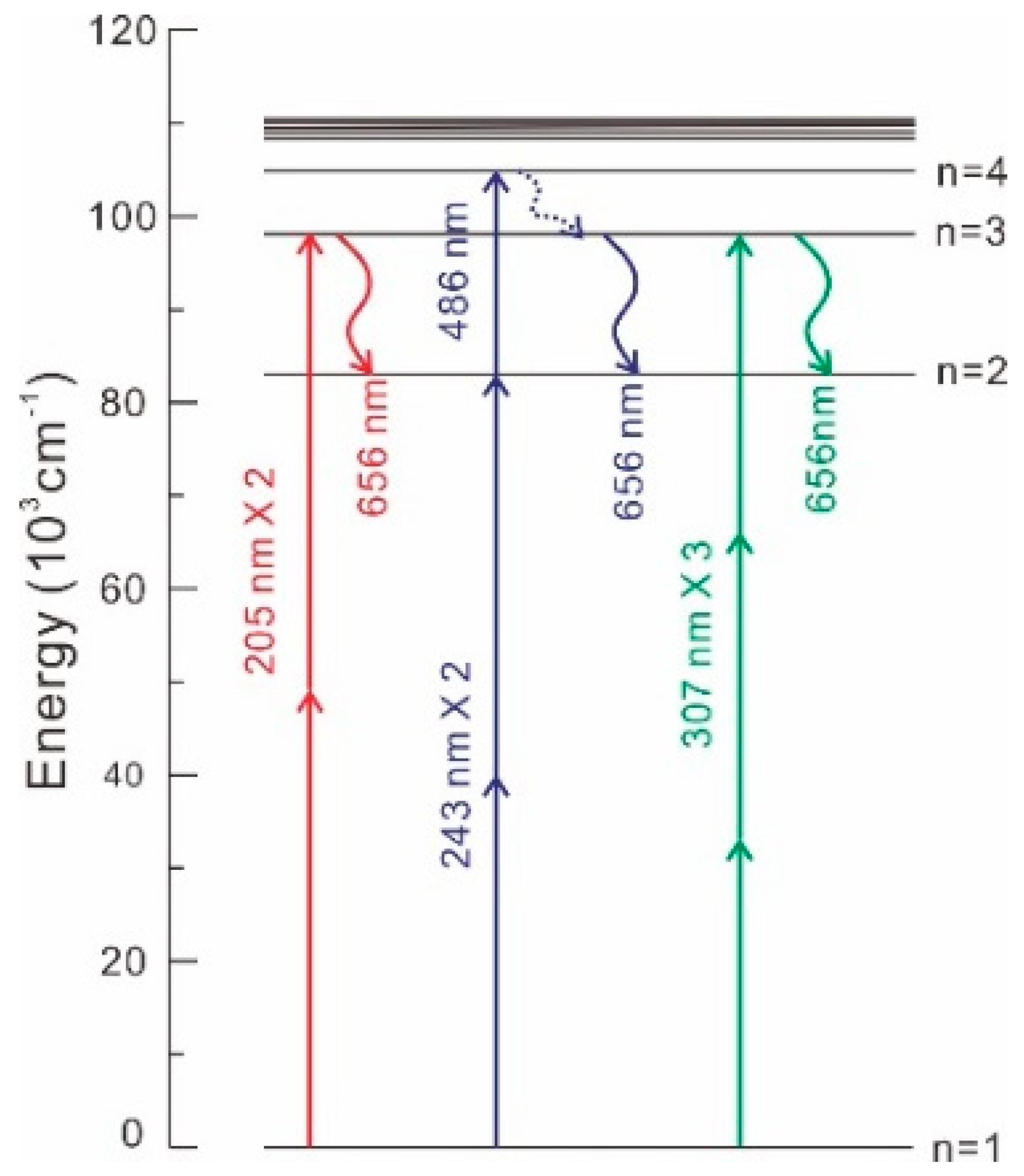



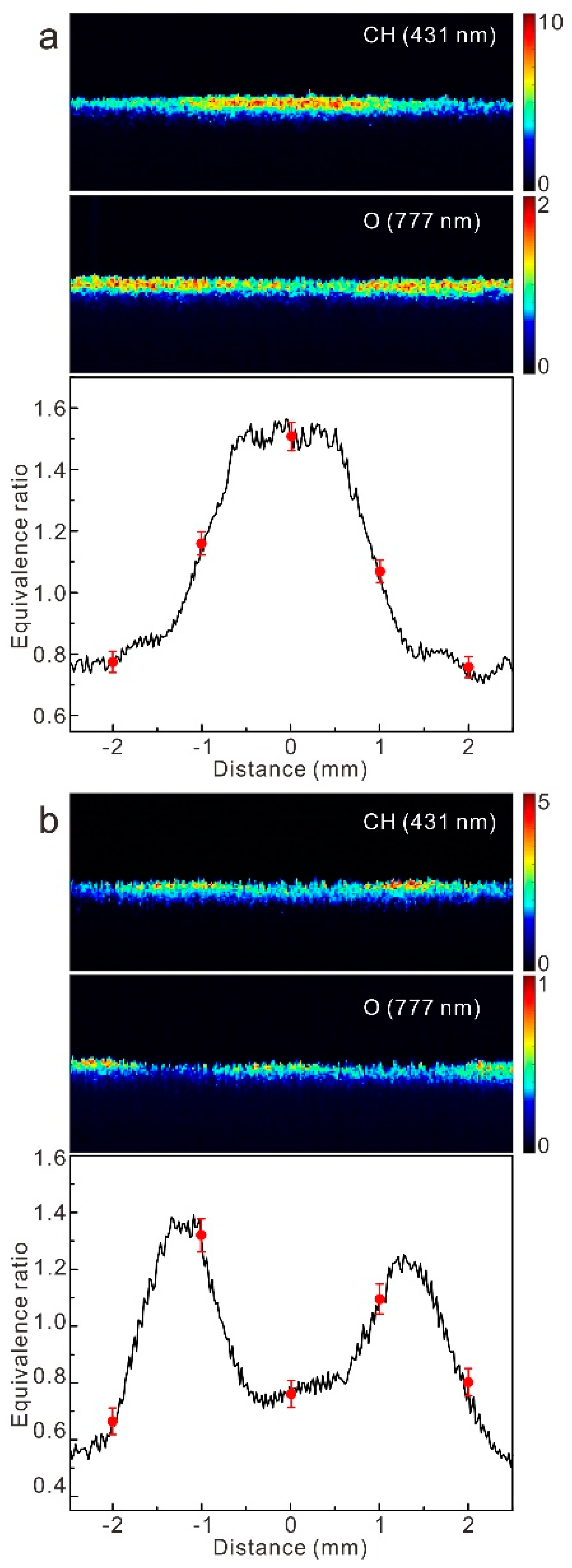
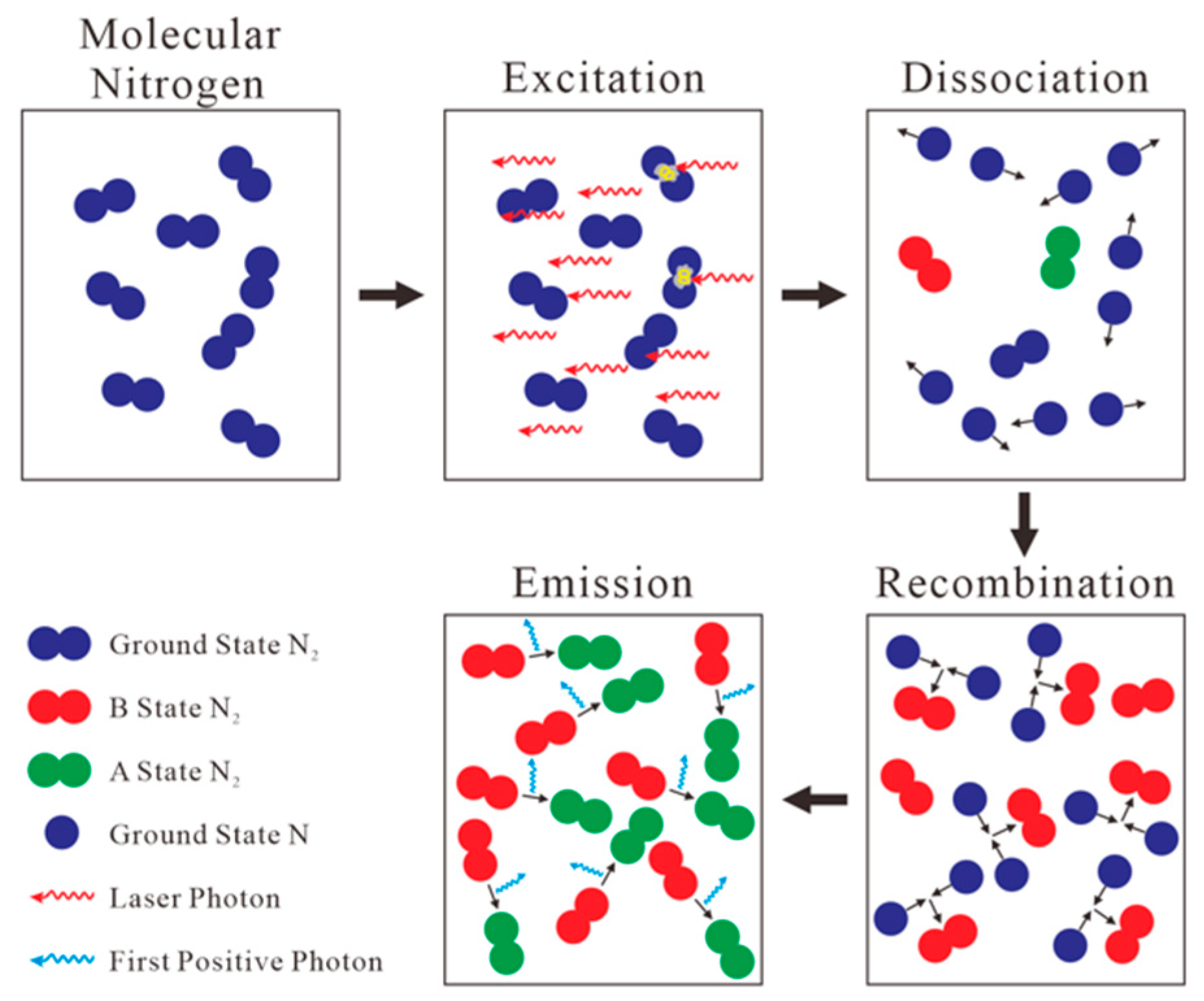
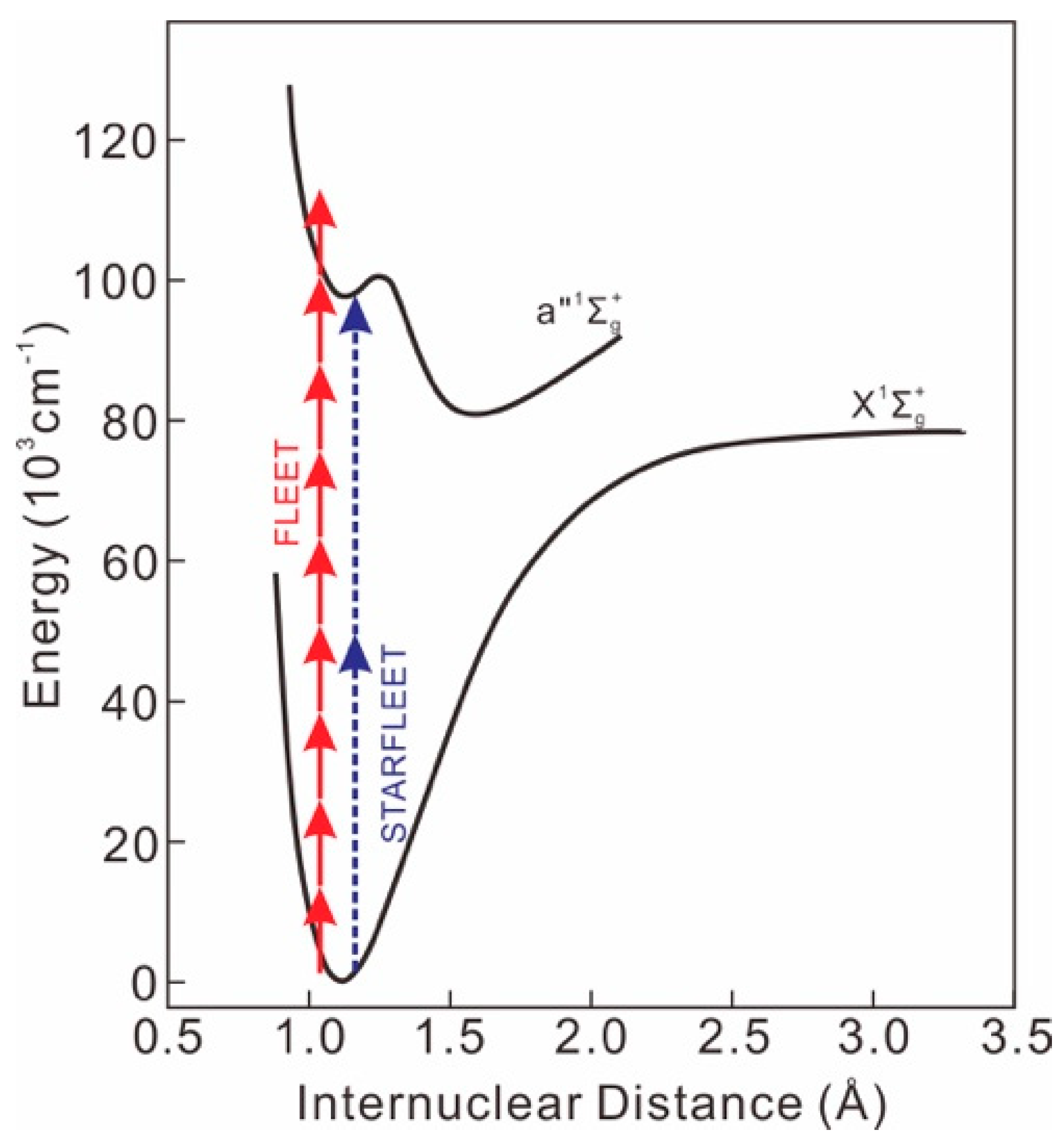
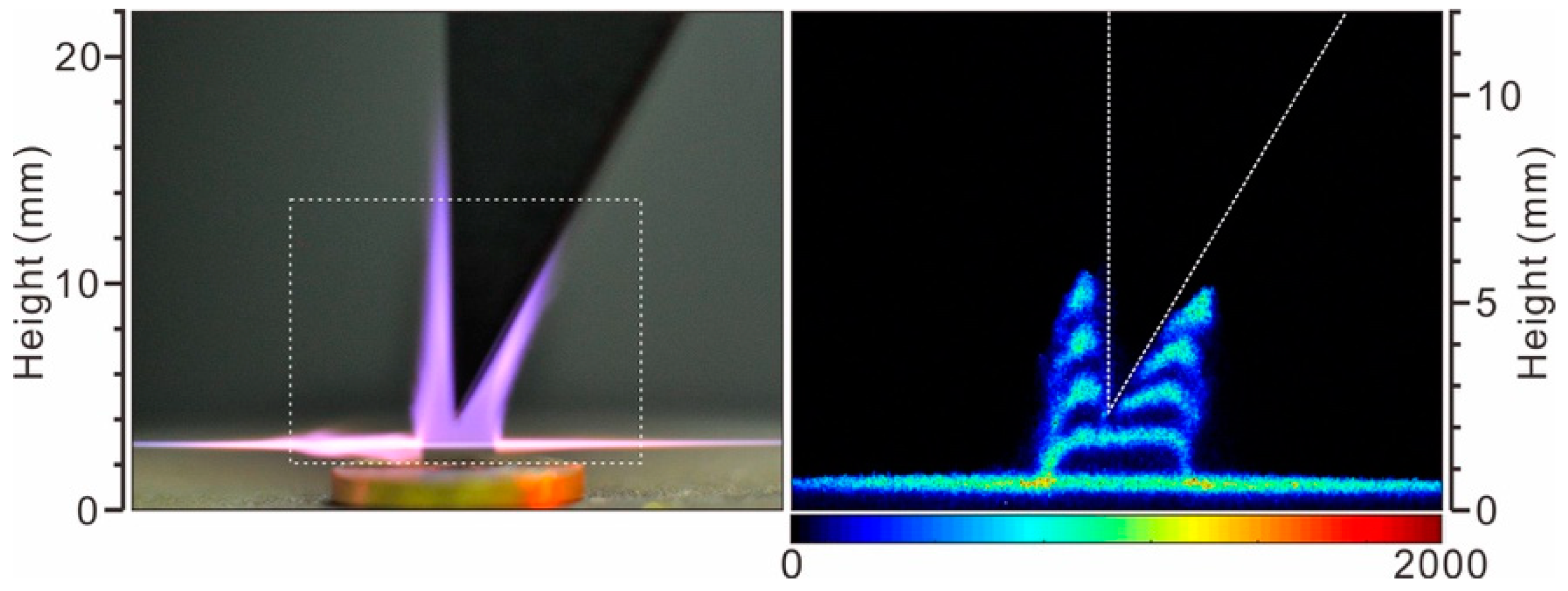

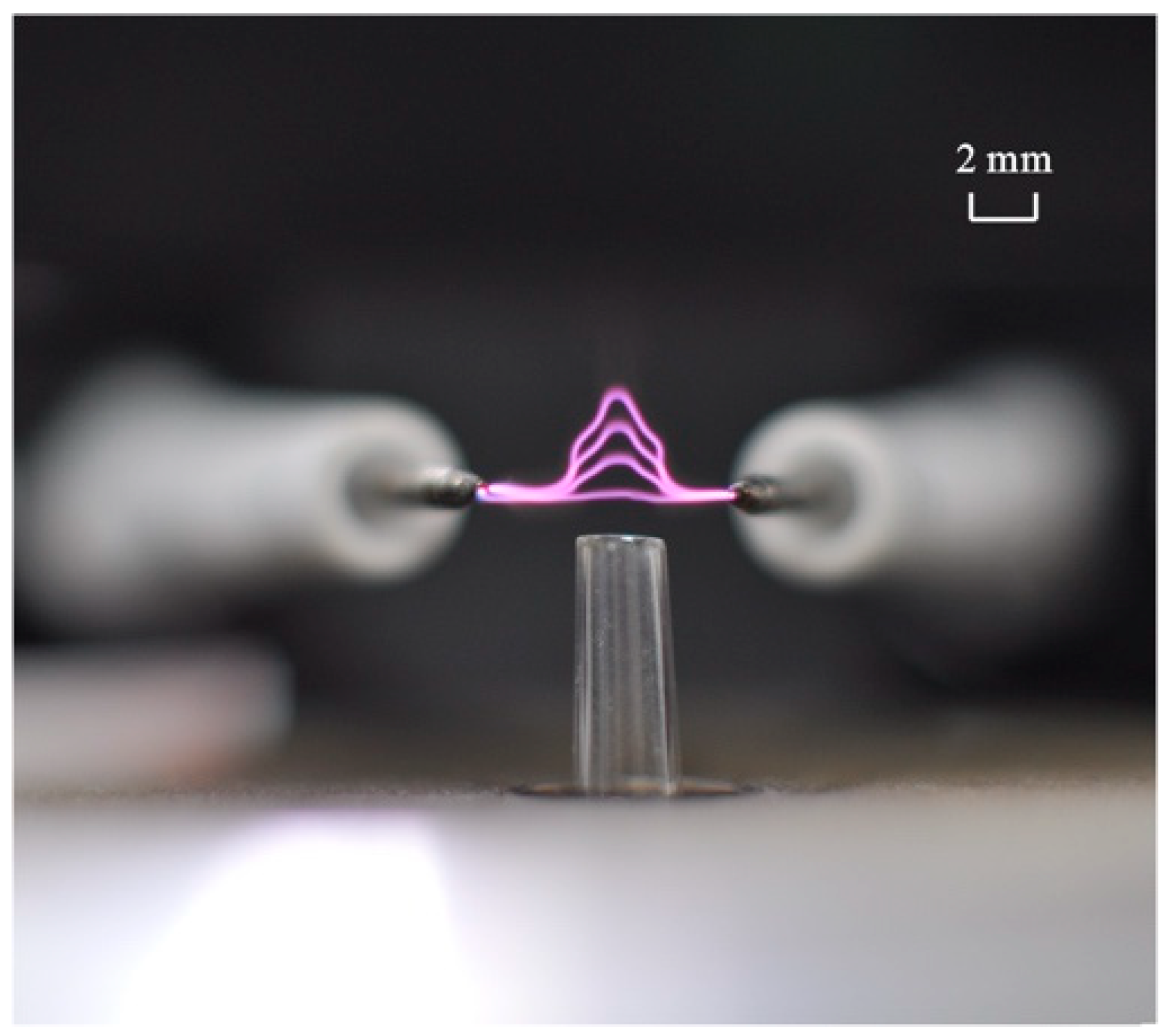
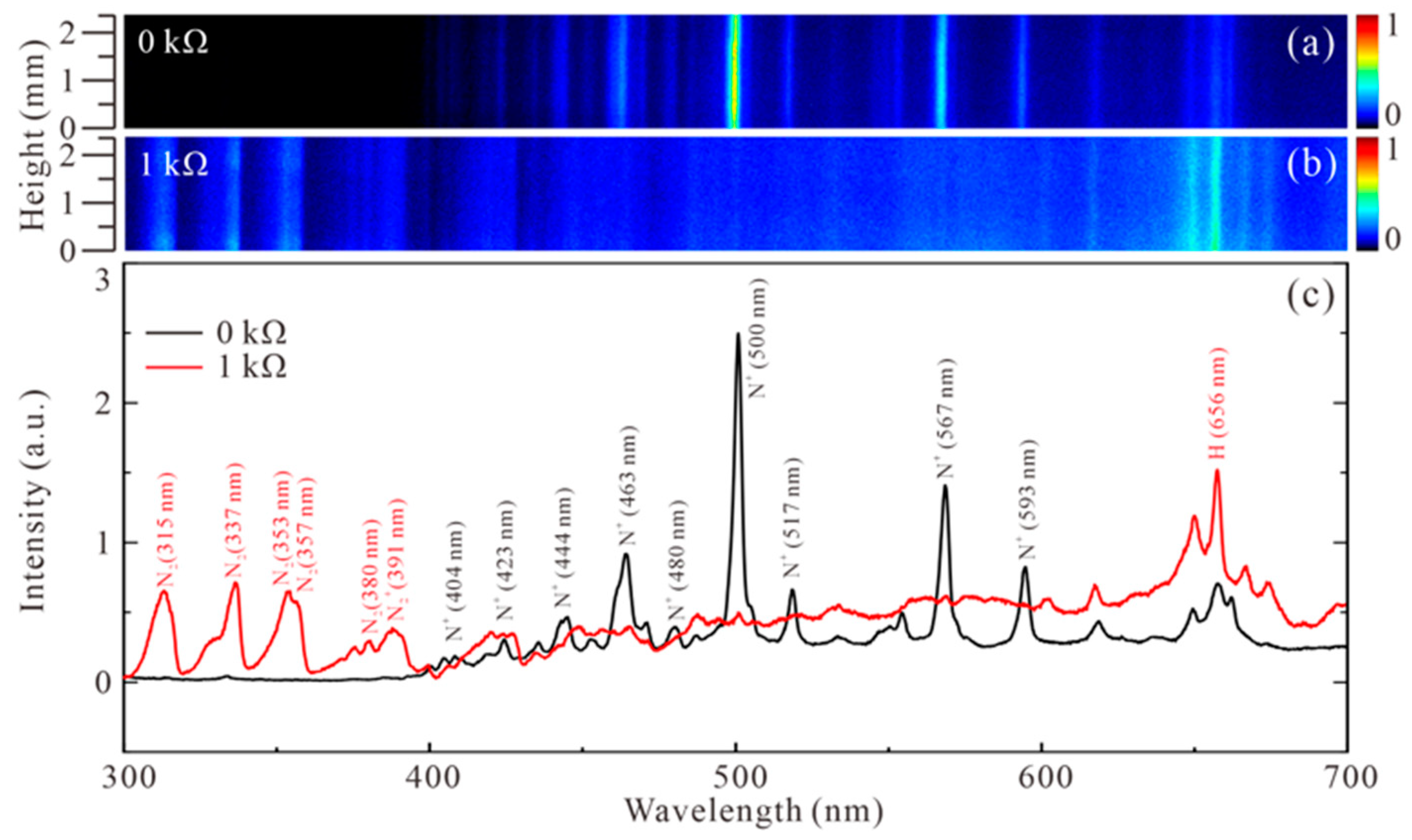
| Species | Excitation | Detection | Ref. | ||
|---|---|---|---|---|---|
| Wavelength | Transition | Wavelength | Transition | ||
| OH | 620 nm*2 | ~310 nm | [31,32] | ||
| CO | 230 nm*2 | 400–600 nm | [27,33,34,35,36,37,38] | ||
| 230 nm*2 | 280–380 nm | [34] | |||
| H | 205 nm*2 | 656 nm | [30,39,40,41,42,43,44,45,46,47,48,49,50] | ||
| 307 nm*3 | 656 nm | [40,47] | |||
| 243 nm*2 + 486 nm | 656 nm | [51] | |||
| O | 226 nm*2 | 845 nm | [49,52,53] | ||
| Kr | 204.1 nm*2 | 826 nm | [49,50,54] | ||
| 204.1 nm*2 | 750–840 nm | [55,56] | |||
| 212.6 nm*2 | 759 nm | [57] | |||
| Xe | 225 nm*2 | 835 nm | [49,53] | ||
© 2019 by the authors. Licensee MDPI, Basel, Switzerland. This article is an open access article distributed under the terms and conditions of the Creative Commons Attribution (CC BY) license (http://creativecommons.org/licenses/by/4.0/).
Share and Cite
Li, B.; Zhang, D.; Liu, J.; Tian, Y.; Gao, Q.; Li, Z. A Review of Femtosecond Laser-Induced Emission Techniques for Combustion and Flow Field Diagnostics. Appl. Sci. 2019, 9, 1906. https://doi.org/10.3390/app9091906
Li B, Zhang D, Liu J, Tian Y, Gao Q, Li Z. A Review of Femtosecond Laser-Induced Emission Techniques for Combustion and Flow Field Diagnostics. Applied Sciences. 2019; 9(9):1906. https://doi.org/10.3390/app9091906
Chicago/Turabian StyleLi, Bo, Dayuan Zhang, Jixu Liu, Yifu Tian, Qiang Gao, and Zhongshan Li. 2019. "A Review of Femtosecond Laser-Induced Emission Techniques for Combustion and Flow Field Diagnostics" Applied Sciences 9, no. 9: 1906. https://doi.org/10.3390/app9091906
APA StyleLi, B., Zhang, D., Liu, J., Tian, Y., Gao, Q., & Li, Z. (2019). A Review of Femtosecond Laser-Induced Emission Techniques for Combustion and Flow Field Diagnostics. Applied Sciences, 9(9), 1906. https://doi.org/10.3390/app9091906





